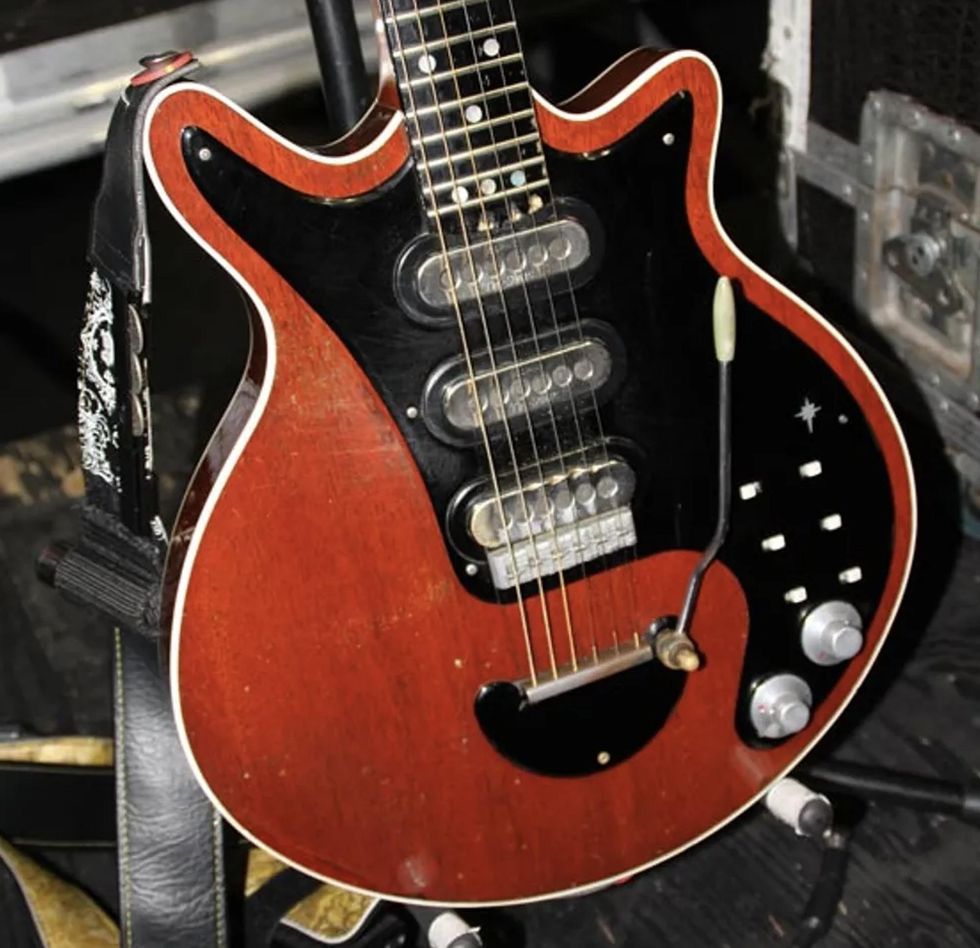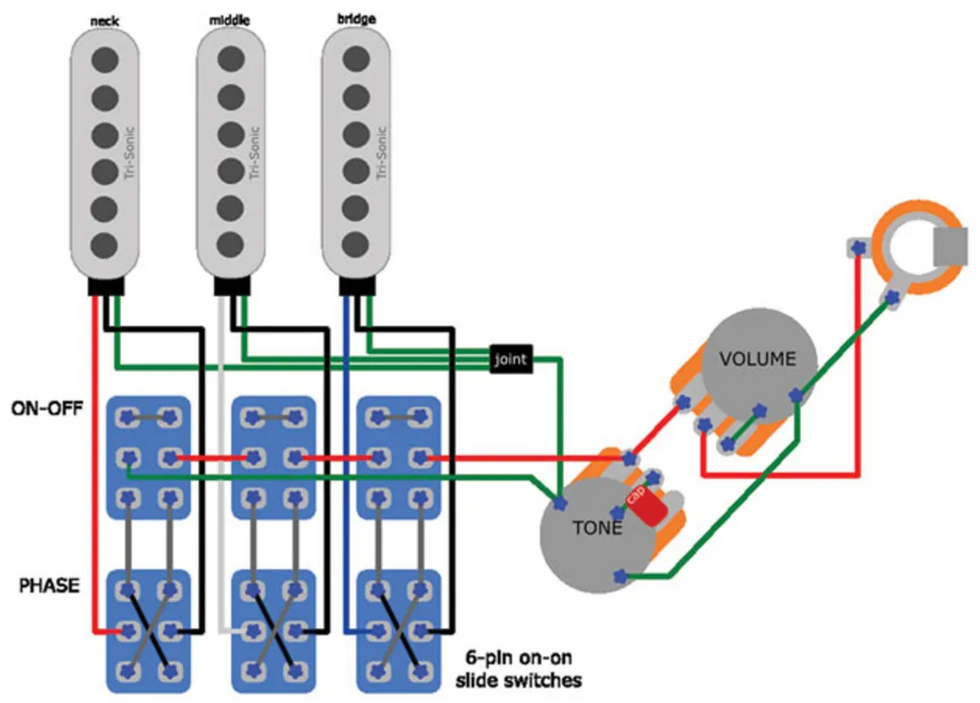Brian May is one of the most immediately identifiable guitarists of all time, and part of his sonic mojo comes from his unique 6-string—the Red Special. Let's explore this instrument to learn how it works and discover how you can mod a production or custom replica to make it even more versatile. Once you understand the electronics, you'll even be able to rewire a Strat to Red Special specs.
Red Special history.
Guitar freaks know the story about May's main axe and how as a kid he built it with his father in the early '60s. From the moment May started playing with Queen—filling stadiums worldwide and recording monster hits—the Red Special's distinctive tone has been essential to his music. What makes this guitar different?
The Red Special boasts three single-coil pickups, Telecaster-style master volume and master tone knobs, and individual on/off and phase switches for each pickup. Like some older Danelectros, its pickups are wired in series rather than in parallel, and this yields a very fat, loud sound.

Photo by Chris Kies
The theory behind series wiring is that the ground wire of one pickup is connected to the hot wire of another pickup. As a result, they become a kind of compound pickup with one ground and one hot for both.
When wired in series, the pickups' impedance (resistance) is summed and the output is very high. (To learn more about series wiring, read "Stratocaster Parallel/Series Switching.")
May's original Red Special is constructed with unusual materials.
The body is made of oak and blockboard, and topped with a mahogany veneer. Its center block and neck consists of an unknown wood taken from an old fireplace mantel, and the fretboard is oak. The result is a kind of semi-acoustic guitar that's almost impossible to copy, but a standard Strat isn't a bad foundation.
If you're intrigued with the idea of configuring a Strat à la May, Image 1 is the wiring diagram for a stock Red Special. Naturally, you can physically arrange the on/off and phase switches to your personal taste.
Pickup details.
A big part of May's tone comes from the Red Special's Burns Tri-Sonic pickups. Though Tri-Sonics are single-coils, they're wider than standard Stratocaster pickups. This means if you want to install a replacement set of Tri-Sonics in your Strat, you'll have to enlarge the pickup holes in the pickguard and reroute the pickup cavities in the body. Fortunately, Burns also offers a drop-in replacement for Strat pickups called the Mini Tri-Sonic. These pickups sport ceramic magnets and a chrome cover, and have a typical DC resistance of around 7k ohms and an inductance of approximately 1.9H.
The Tri-Sonic's unique construction gives it richer harmonics than a standard Stratocaster pickup. In fact, a Strat-sized P-90-style pickup will get you closer to Brian May territory than a Strat pickup. But to get as close as possible, Tri-Sonics are the ticket.
The Red Special boasts three single-coil pickups, Telecaster-style master volume and master tone knobs, and individual on/off and phase switches for each pickup.
Instead of a common 5-way pickup selector switch, May uses an on/off switch for each pickup. This arrangement gives him seven different combinations from the three pickups. Besides the five well-known Strat combinations, he can also pair the bridge and neck pickups, as well as engage all three pickups. His Red Special uses slide switches, but mini-toggle on/off switches work just fine.
A passing phase.
On his Red Special, May also incorporates an individual phase switch for each pickup, so he can reverse its phase in any pickup combination. When two pickups are in phase, they work together and sonically reinforce each other. When they're out of phase, two pickups work against one another, cancelling many frequencies. The resulting sound is the "leftovers" from these cancellations.
Before we go any further, let's review two things about switching pickup phase: You don't have to engage two phase switches—reversing the leads of both pickups puts them back in phase again and thus yields a stock sound. And switching the phase of a single pickup has no audible result. For example, the bridge pickup by itself sounds the same whether it's switched in or out of phase. You can only get an out-of-phase sound when you use two pickups together and only one of them is out of phase.
So why add all these phase switches?
Consider this: There are two ways you can use the bridge and middle pickups together with one of them being out of phase with the other. The bridge pickup can be in phase and the middle out of phase, or the other way around. Each configuration delivers different harmonic content, especially when you're playing with distortion. The difference is subtle, but audible, and May is known for tinkering with this option a lot. It's an important part of his signature tone.
May typically plays with heavy distortion, pushing his amps hard with those series-wired Tri-Sonics. His out-of-phase sounds are an excellent choice for cutting through the mix, and this whole circuit is perfect for his playing style.
To get close to the Brian May tone, there are several more things to consider: He plays with very light strings (.009–.036) and uses an old sixpence coin as a plectrum. He also runs his guitar into a treble booster and a wall of Vox AC30s. There are other details, but to enter the May zone without breaking the bank, use thin strings, pick with a coin, plug into any Rangemaster Treble Booster clone, and use a Vox amp—ideally an AC30.
There is a Vox Brian May signature amp (the VBM-1), which was designed to mimic his studio sound and has a built-in treble boost circuit. Though the amp is no longer in production, it sometimes shows up used on eBay.
There are a lot of mods out on the web for Red Special replicas and clones, mostly designed to coax more sounds out of the guitar. My favorite (Image 2) is by John Hewitt, an Australian guitar tech and the mastermind behind the GuitarNuts website. This mod incorporates series/parallel pickup switching, leaves all stock wiring sounds untouched, and only requires one additional switch, which acts as a master series/parallel switch. Parallel switching of the pickups offers more traditional Stratocaster tones. Compared to the series wiring, it has reduced output but delivers enhanced clarity, twang, and top end.
All you need for this is a 4PDT mini toggle or slide switch. A mini toggle switch should be easy to acquire, but finding a 4PDT slide switch can be more difficult. Using the new switch is fairly simple: Dial in a pickup combination of your choice—for example, bridge-plus-middle—and you'll hear them connected in series (the stock wiring). If you want a more Strat-like sound, flip the new switch and both pickups are now wired in parallel for a more traditional tone. Flip it again and you are back to the stock series wiring.
This isn't an easy wiring project, so be methodical and don't rush through it. The third pickup wires (not shown in Image 2) from the Tri-Sonics are twisted together and soldered to ground as shown in Image 1's stock wiring (represented in green).
And that's it! Until next time, keep on modding!
[Updated 9/28/21]






































